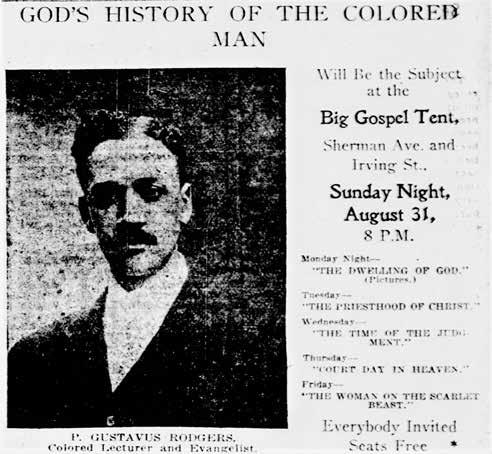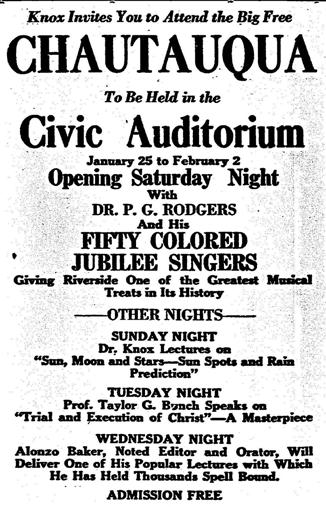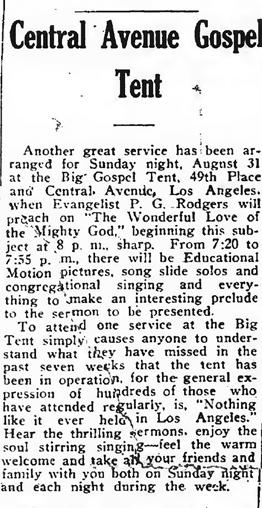
11 minute read
P.G. Rodgers: Builder of Black Adventism
P. G. Rodgers:
Builder of Black Adventism
By Douglas Morgan
Dr. H. Claude Hudson, president of the Los Angeles chapter of the NAACP, and Charlotta A. Bass, publisher of the California Eagle, Southern California’s leading Black newspaper, were among the guest speakers at Wadsworth Seventh-day Adventist Church in Los Angeles on January 7, 1931. They were there both to celebrate the 25th wedding anniversary of the church’s pastor, P. G. Rodgers, and his wife, Alverta Durham Rodgers, and “to congratulate the church on the rapid strides it has made under the leadership of Elder Rodgers.”1
The presence of these community leaders, reported on the front page of the Eagle, is one marker of the impact made by Rodgers’ ministry. In Los Angeles, and before that P. Gustavus Rodgers in Baltimore and Washington, D.C., Peter Gustavus
SOURCE: OAKWOOD UNIVERSITY ARCHIVES Rodgers (1885-1961) proved to be one of Adventism’s most effective spokespersons in America’s Black urban communities during the first four decades of the 20th century. He was likewise a leading voice in the struggle for Black equality within the church.
Born in Philadelphia, Pennsylvania, on August 10, 1885, Gustavus Rodgers was the sole convert resulting from evangelistic meetings conducted by Fred H. Seeney in Wilmington, Delaware, in 1908. Gustavus and Alverta, married in 1906, both had roots in the Delaware-based people of ambiguous racial heritage known as “the Moors.”2 The couple’s light complexions sometimes confused people. When, for example, they arrived in Los Angeles in 1923, their congregants reacted with surprise, thinking that the conference had sent a white man to be their minister.3 Yet there was nothing ambiguous about their identity as Black or about
P. G. and Alverta Rodgers with unidentified couple.
SOURCE: DUPONT PARK SEVENTH-DAY ADVENTIST CHURCH, WASHINGTON, D.C.
their dedication to racial advancement.
A carpenter by training, Rodgers quickly demonstrated exceptional gifts for ministry and was hired by the Chesapeake Conference in 1910, assigned to Baltimore in late 1911. He arrived to a congregation of 11, their building “in a half-wrecked condition.” When his pastorate at Baltimore Third church (later named Berea Temple) concluded six years later, the membership had grown from 11 to 300, a church building had been acquired and renovated with over 75% of the mortgage paid, and a thriving church school had been established.4 It was the beginning of a pattern.
At the Ephesus church in Washington, D.C., Rodgers’ next assignment, he again placed a high priority on the quality of the house of worship as foundational to evangelism. After a major renovation completed in 1919, Rodgers claimed that the Ephesus structure now ranked “among the most modern and beautiful of our houses of worship.”5
At the outset of his ministry in Washington, D.C., Rodgers used a special lecture he had originated in Baltimore to show that he and the movement he represented had something of importance to say about the dilemmas specific to the African American experience. He spoke on “The Black Man as God Sees Him, or the Inspired History of the Negro” at Black America’s leading cultural and intellectual forum, the Bethel Literary and Historical Society, on November 26, 1918. W.E.B. Du Bois and A. Philip Randolph were among the other lecturers during the society’s 1918-1919 season.
Such presentations helped stir interest in Rodgers’ expositions on the Bible delivered at the “Big Gospel Tent” on Sherman Avenue during the summers of 1918, 1919, and 1920. Rodgers baptized more than 200 new believers while at Ephesus, including three noteworthy individuals, all baptized on December 5, 1920: Willie Anna Dodson, on her way to a path-breaking career as a public school administrator; her husband, Joseph T. Dodson, an entrepreneur with an intellectual bent; and Eva Beatrice Dykes, about to become the first African American female to complete Ph.D. requirements. All three would become part of the lay committee that spearheaded denomination-wide change in race relations during the 1940s, a story told in the book Change Agents, published by Oak & Acorn in 2020.
In 1923, Rodgers was called to pastor the East

36th Street church in Los Angeles. Organized in 1908 with the name Furlong Tract, it was the first Black Adventist church on the West Coast. Several of the young people who came of age in this fellowship would make notable contributions in both church and society. These included evangelist and church leader Owen A. Troy, pioneering public health advocate Dr. Ruth J. Temple, and educator and author Arna Bontemps, prominent in the Harlem Renaissance. When the congregation moved to a new building on East 36th Street in 1922, it had a relatively strong membership of 99. But that was about the same as it had been a decade before. Adventism still was barely touching the booming Black population of Los Angeles.
In the summer of 1924, Rodgers set up the 1,000-seat Big Gospel Tent on Central Avenue in the heart of the Black community for three months of evangelistic meetings. This would become an annual, summer-long happening for most of the next 15 years. The 1924 campaign drew nearcapacity crowds on Sunday nights and 400 to 600 on weeknights, including sizable contingents of white people. The church membership doubled to 200 as a result, making it clear already that a larger church building would be necessary.6

SOURCE: WASHINGTON EVENING STAR , NOVEMBER 29, 1919.

Rodgers in front row with Black delegates and guests at the 1926 General Conference Session, Milwaukee, Wisconsin.



The California Eagle described the new 800-seat church, completed in the summer of 1927 on the corner of 35th Street and Wadsworth Avenue, as “one of the finest churches in the city.” With music also a top priority, a “beautiful alcove” behind the pulpit accommodated a Moller pipe organ along with the church’s large choir that, according to the Eagle, was “known far and wide in the city for the artistic nature of its work.”7 Rodgers, along with other church members, joined in the construction work to help keep costs down. Less than two years later, on March 2, 1929, the 300-member church held a “noteburning service” to celebrate final payment on the debt.
Rodgers honed his method of drawing crowds with “thrilling sermons” that framed Adventism’s end-time warning message in issues of current public interest. In July 1936, for example, with European dictators stirring widespread anxieties about another world war and Italian aggression in Ethiopia arousing particular concern among African Americans, a large headline in the California Eagle announced, “Elder Rogers to Discuss Ethiopian Situation.” That discussion apparently was to be part of a broader presentation under the title announced for the July 28 meeting, “Can Just Four Angels Hold in Check the Hatred of the Nations?” Rodgers now made heavy use of slides, and for this topic he promised that close to “four score marvelous and beautiful pictures will be thrown on the big screen.”8 Rodgers’ ministry was not restricted to the Black community. He served on the Southern California Conference executive committee from 1927-1937 and was frequently a featured speaker at camp meetings and other conference-wide gatherings. He also lent his preaching and the music of his renowned choir, for which he appropriated the name Jubilee Singers, in support of the efforts of leading white evangelists, such as H.M.S. Richards Sr. and Philip Knox.
As he had been in Baltimore and in Washington, D.C., Rodgers was a relentless and passionate activist for equal opportunity in Christian education in Southern California. Though delayed by the


Great Depression, a major advance took place in 1936 when the Wadsworth School opened with 68 students in eight grades. Two years later, it had become a junior academy with an enrollment of 112.
In 1938, restrictions on placement opportunities for Black interns by the College of Medical Evangelists (CME) in nearby Loma Linda drew vigorous protest from Rodgers. The preacher thought he had mediated a solution that satisfied both the NAACP and the General Conference administration, but he was outraged when the CME board voted a change to the wording of the policy in a way that, he contended, changed nothing in actuality. He warned that the NAACP would not let the matter go and declared that the only reason he could imagine for such a “regrettable action” was that “the spirit of a doomed world is getting into the hearts of the leaders of Israel.” Rodgers urged
Rodgers’ outspokenness on racial matters apparently made some church leaders feel uneasy about his loyalty to denominational organization. In fact, his very success as a pastor-evangelist made him suspect in an era when three of his contemporaries who were likewise effective became alienated from the denomination over racial issues: Lewis C. Sheafe (1916), John W. Manns (1916), and James K. Humphrey (1930). As one General Conference administrator put it, the basic concern about Rodgers was that “he was a man who has drawn very strongly to himself.”10 In other words, he was perceived as exerting too much personal influence over his large congregation.

In 1940, his pastorate in Los Angeles having extended to an unheard-of length of 17 years, the pressure grew on Rodgers to accept a call elsewhere. He resisted doing so in part because his wife Alverta suffered from a respiratory condition that the Southern California climate made more tolerable. Additionally, the 55-year-old preacher was beginning to show signs of serious health difficulties of his own. In the end, it seemed that the best solution was for Rodgers to accept a leave from full-time ministry due to disability.
Alverta’s health worsened in 1941 due to “heart trouble,” and she died on June 16, 1942. Though her role went almost completely unmentioned in public reports, she had been an active and indispensable partner in her husband’s ministry from the beginning more than 30 years before.
P. G. Rodgers never returned to full-time ministry, though he did preach occasionally until 1959, when he put up for sale his collection of “3,000 color stereopticon slides,” along with a “Bausch and Lomb dissolving lens machine” that he had used in leading 1,008 individuals to baptism during his time in California.11 Despite his persistent agitation against racial injustice in the church and the disappointment surrounding his early retirement, Rodgers testified in 1960, “I have loved every phase of the Message during these years and have never doubted one line of it.”12 He died in La Mesa, California, on September 24, 1961, at age 76.
P. Gustavus Rodgers was both a powerful evangelist and a personable congregation-builder, a visionary promoter and a pragmatic leader skilled in bringing dreams to reality, unreserved in his dedication to the mission of the church and unrelenting in urging it toward a more Christ-like pattern of race relations.
Adapted by permission from the Encyclopedia of Seventh-day Adventists, encyclopedia.adventist.org. For full documentation and a more detailed treatment of Rodgers’ career, see “Rodgers, Peter Gustavus (1885–1961),” Encyclopedia of Seventh-day Adventists, https://encyclopedia.adventist.org/article?id=ACFJ.
1“Seventh Day Adventist Church Fetes Pastor and Wife on the Occasion of the Couple’s Silver Wedding Anniversary,” California Eagle, Jan. 9, 1931. 2C.H. Weslager, Delaware’s Forgotten Folk: The Moors and the Nanticokes (Philadelphia: University of Pennsylvania Press, 1943). 3Louis B. Reynolds, We Have Tomorrow: The Story of American Seventhday Adventists with an African Heritage (Washington, D.C.: Review and Herald Pub. Assn., 1984), p. 177. 4Gustavus P. Rodgers, “The Work Among the Colored People in the Chesapeake Conference,” Review and Herald, Feb. 21, 1918, p. 17. 5Gustavus P. Rodgers, “Work for the Colored Believers in Washington, D.C.,” Review and Herald, July 17, 1919, p. 24. 6Mrs. A.H. Baker, “East Thirty-sixth Street Church,” Pacific Union Recorder, Sept. 11, 1924, p. 3. 7“Seventh Day Adventist Church Fetes Pastor and Wife,” pp. 1, 3. 8“Elder Rogers to Discuss Ethiopian Situation,” California Eagle, July 18, 1936, p. 10. 9P.G. Rodgers to W.E. Nelson, Jan. 6, 1939, General Conference Archives, RG 11, Box 3957. 10H.T. Elliott to W.G. Turner, June 9, 1040, GCA, Sustentation Files, RG 33, Box 9774, P. Gustavus Rodgers. 11Advertisements, Pacific Union Recorder, July 27, 1959, p. 14. 12P.G. Rodgers to R.H. Adair, Feb. 5, 1960, P. Gustavus Rodgers Sustentation File, GCA.










